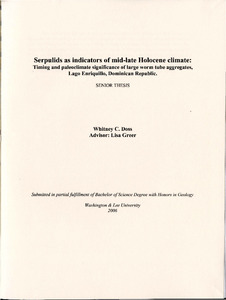| dc.rights.license | In Copyright | en_US |
| dc.creator | Doss, Whitney Crawford | |
| dc.date.accessioned | 2023-10-20T17:40:12Z | |
| dc.date.available | 2023-10-20T17:40:12Z | |
| dc.date.created | 2006 | |
| dc.identifier | WLURG038_Doss_thesis_2006 | |
| dc.identifier.uri | https://dspace.wlu.edu/handle/11021/36344 | |
| dc.description.abstract | Large aggregates of calcareous serpulid worm tubes recorded paleoclimate conditions as they colonized the mid to late Holocene Enriquillo embayment, Dominican Republic. Serpulid worms flourished in the embayment following the demise of a coral reef complex due to the abrupt cessation of normal marine circulation. While serpulid tubes are found in thin layers and as single tubes encrusting corals in normal marine deposits around the present-day hypersaline lake, they dominated the initial restricted environment in a unique aggregate form. Large monospecific mounds up to 2.8 m in height cap the reef sequence and occur in tiers marking the extent of different paleoshorelines around the periphery of the valley. Initially, serpulids colonized hard coral substrates such as large Montastraea annularis colonies and Acropora cervicornis rubble, but some may have even colonized live coral. The mounds are coated with a thick tufa rind. Stable carbon and oxygen isotopic data in conjunction with 230Th/234U and C-14 dating suggest a transition to hyposaline conditions ~4000 ybp, about the time of the earliest mound accumulation. High resolution geochemical analyses indicate that sub-annual paleoenvironmental data may be extracted from individual serpulid tubes. Results of high resolution sampling from individual tubes indicate considerable variability in temperature and salinity conditions throughout the period of tufa-coated serpulid mound formation, significantly more so than in tubes formed under normal marine conditions. Also, data suggests that an overall Holocene transition from warm/wet to more arid climate patterns resulted in the closure of the embayment and the creation of optimal conditions for such massive serpulid colonies. | en_US |
| dc.format.extent | 36 pages | en_US |
| dc.language.iso | en_US | en_US |
| dc.rights | This material is made available for use in research, teaching, and private study, pursuant to U.S. Copyright law. The user assumes full responsibility for any use of the materials, including but not limited to, infringement of copyright and publication rights of reproduced materials. Any materials used should be fully credited with the source. | en_US |
| dc.rights.uri | http://rightsstatements.org/vocab/InC/1.0/ | en_US |
| dc.subject.other | Washington and Lee University -- Honors in Geology | en_US |
| dc.title | Serpulids as Indicators of Mid-late Holocene Climate: Timing and Paleoclimate Significance of Large Worm Tube Aggregates, Lago Enriquillo, Dominican Republic | en_US |
| dc.type | Text | en_US |
| dcterms.isPartOf | WLURG038 - Student Papers | en_US |
| dc.rights.holder | Doss, Whitney Crawford | en_US |
| dc.subject.fast | Holocene Geologic Period -- Dominican Republic | en_US |
| dc.subject.fast | Paleoclimatology -- Research -- Dominican Republic | en_US |
| dc.subject.fast | Geology -- Dominican Republic | en_US |
| dc.subject.fast | Serpulidae -- Dominican Republic | en_US |
| local.department | Geology | en_US |
